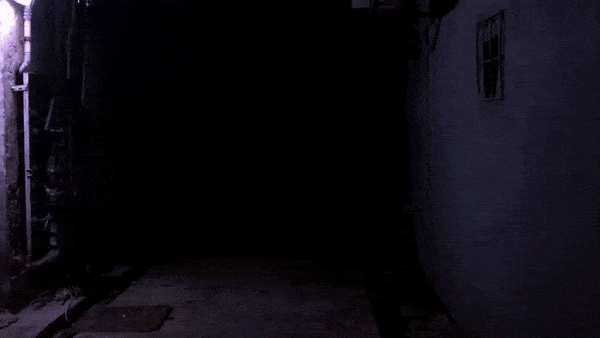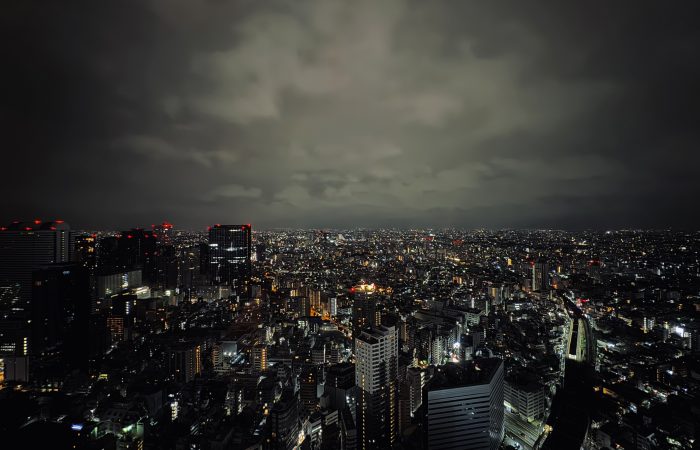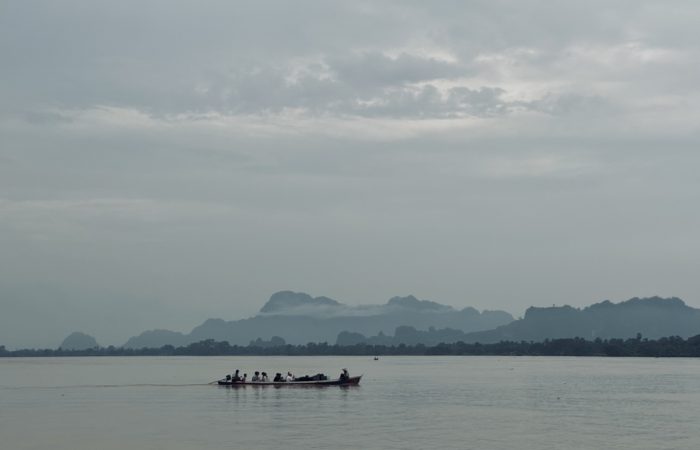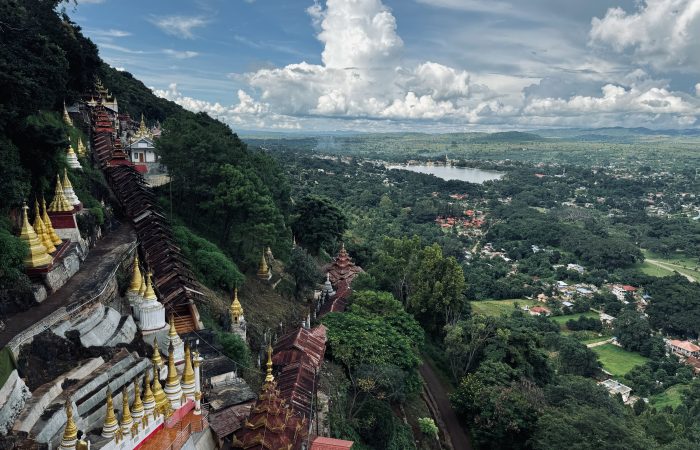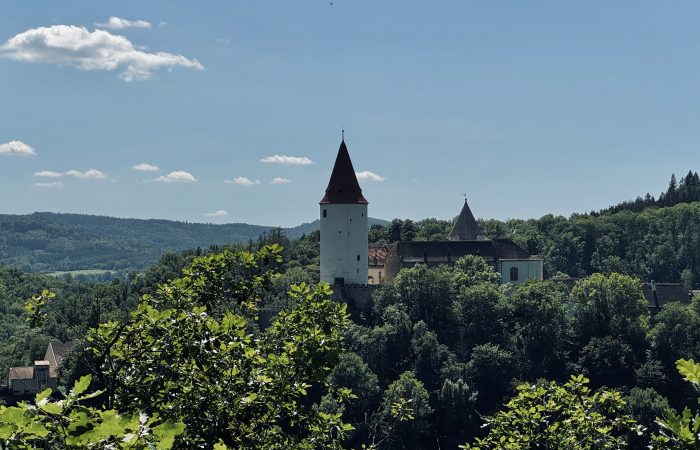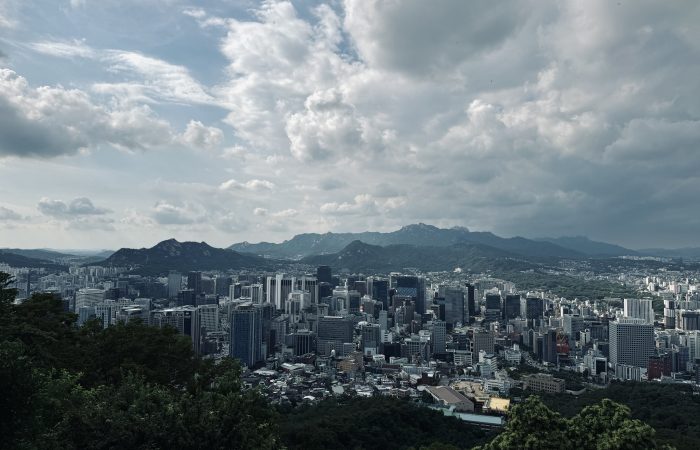
Contact
Blog
18 October 2024
Hong Kong, HKSAR
shadows turn / to new shadows / faces elide, the final poem in Taneli Viljanen‘s magnificent poetic cycle exclaims. The sound is not quite what one expects- it comes from a little speaker, ‘performing’ (wirelessly) a music of the past, written in the recent present, dreaming subtly of the future. The three performers approach the speakers, whose sound, at first clear if slightly muffled, turns to interrupted, overwhelmed, and ultimately relented into a gentle sea of static and resonance. They stand mostly emotionless. A tear might appear. It has, many have, every time.
I really had very little conception of how the premiere of Otherhood (2022) would go. I didn’t know what I was doing with the piece when I wrote it, anyway. After five huge projects, over five hours of music for some of the world’s leading ensembles incorporating the latest technology and so on, to return to a small form (still in a fairly ambitious package of over thirty minutes of music) was intimidating. There is truly nowhere to hide with a piano and two voices, and writing in the genre of the lied cycle, where over two hundred years of common practice has created an incredibly rich and, more importantly, canonic sound, means daring to say, “there is still a stone unturned, and here, I have unturned it.”
But sometimes one gets very lucky indeed. For whatever reason, I’ve been incredibly privileged to work with some of the most incredible, talented musicians on this planet, the multiple Grammy-award winning Iris Oja, Martti Anttila, and Anna Kuvaja, who on October 6th, gave an absolutely tour de force performance of the work at the Musiikkitalo in Helsinki. Having written the piece over various weeks on two continents, I could look back on the process only in a sort of daze- it is, itself, going through the piece from start to finish, a kaleidoscopic ‘trip’ through the intensely subconscious experience of listening, remembering, imagining. Triad after triad, colour after colour (never have I written something so ‘major’ and colourful!), the work seems to circumnavigate the world of experiencing something old anew, and ending on the nostalgia of just the experience itself. Those almost-last words of Taneli’s, the merging of everything, it happens at the very end in a way that nobody really could imagine at the beginning. But somehow we find it all incredibly familiar anyway.
1 October 2024
Hong Kong, HKSAR
I have somehow – truly unsure how! – made it through September, surely one of the busiest months of my life. October will make a valiant effort for the title, however! I’m off on Thursday to Helsinki for the world premiere of Otherhood (2022), the thirty-minute song cycle commissioned by the Finnish Cultural Foundation on newly written (and absolutely gorgeous) poetry by Taneli Viljanen, performed by Martti Anttila, Iris Oja, and Anna Kuvaja. The world premiere, as I am a broken record and have linked it far too many times already, is on October 6th at the Musiikkitalo!
Later in the month brings me to Zurich, Switzerland for the European premiere of Vivacissimo (2023) in a new version with a video by Pavel Otdelnov, the award-winning Russian painter, and Kihako Narisawa, a brilliant Germany-based dancer and multidisciplinary artist who will design a new choreography to Pavel’s new film. Though I originally wanted to bring as much of the original production as possible, this become unrealistic due to the intransigence of the original creative partners, and I must say I’m excited beyond words to see what will come out of this new collection of truly great artistic spirits. Of course, LiLa, the brilliant Chinese cellist who premiered the work will reprise it, and I wouldn’t have it any other way!
And new work- it’s been slightly too long since something truly ambitious and new has been on the horizon, but certain projects are either back on track or, beyond that, taking shape. But before any more announcements, the digital collaboration for the Hong Kong Ballet with Anandi Bhattacharya on vocals (and, genuinely, co-composer), Joby Burgess, percussion, Shen Jie as the soloist-dancer, Yuh Egami, choreographer, and Giorgio Biancorosso as conceptual lead and director, which we have dubbed Apparition, is almost here. I’m incredibly proud of what we did, the level of music, choreography and, indeed, special effects stands up to the very best globally and considering the modest budget- it’s simply magic. More on that next time.
15 September 2024
Mawlamyine, Myanmar
This post begins with this rather atmospheric photograph, but it ends, predictably, at some news and plans. The first two weeks as (Acting) Director of the Academy of Music have been even busier than feared, but with the responsibilities comes something to work or strive towards, some meaningful contribution that regardless of my general unsuitability for administrative work, I can certainly take on.
Rain-soaked (frankly, quite flooded), looking like something from a century or two ago, this is the Salween river, one of the longest in Asia in fact, but little known given that it spends its almost three thousand mile course in some of the least explored regions on the continent, charging through the inhospitable Tibetan Plateau, down the steep gorges of Sichuan, through the mysterious Shan hills, and out through the surreal landscapes of the Kayin and Mon states of Myanmar. It’s not particularly navigable much further up than this and serves little commercial function, though it was the pathway that the Burmese, and many other Southeast Asian peoples, first migrated down from Tibet to the rice paddies and limestone mountains of southern Myanmar. They probably couldn’t have believed their eyes staring at the verdant, rocky outcrops studding the countryside like ships; it’s hard to believe my eyes that a place like this still exists.
It will be a very different picture in a few weeks’ time given that the world premiere of Otherhood (2022) is now approaching; the date and time are set, at 5pm, October 6th, at the Camerata at Finland’s most important performance venue, the Musiikkitalo. I’m worried about this piece, given that it confronts one of the most beloved genres in classical music, the lied recital. All thirty minutes of it, with still not-properly-tested technology, and a lot of complicated and experimental ideas- what will it actually sound like? I have no idea. I wrote it across oceans, as always, and it breathes the musty air of Mumbai as much as the chilly mornings of my home in Oakland, California. It lives in a weird in-between of past and future, and, just like Taneli Viljanen‘s wonderful poetry, it is neither one, or another, but both, and neither, everything and nothing. Staring out onto the river delta as the sun sets in burnt orange hues, a far cry from the muted tones of the afternoon, one sees the great terror and beauty in what is truly unknown.
2 September 2024
Hong Kong, HKSAR
The beginning of the semester has been slightly more eventful than ever previously. Taking on the role of Acting Director of the Academy of Music has clearly brought new responsibilities, challenges, and surely opportunities, too. Later this week, I will moderate a conversation between myself and the creative team behind the new Wayne McGregor production, the Academy Award-winning Nicolas Becker (who did the sound design for one of my all-time favourite films, La Haine), and LEXX. The rest of the month will be spent preparing for the world premiere of Otherhood (2022) in Helsinki in early October, time still to be fixed, but date certainly the 6th, and venue- the venerated Musiikkitalo. And that’s just a taste of what’s coming.
I got to spend a couple days in Myanmar, once again, and the visit did not come without significant trepidation. The headlines are increasingly ominous, but the situation, even in the perpetually politically unstable Shan state, was absolutely peaceful- having a chance to enter the Danu self-administered zone, specifically to see Pindaya, one of the most sensational Buddhist sites in the world, was a privilege I’ll surely never forget, and clear evidence that, once again, like always, never believe what you read. The reality is always different, and depends as much on worldly circumstances as it does on the numinous ones.
Somehow all this inspiration has run up against the wall, or rather, the reality of responsibilities. There is simply so much to be done in every aspect that the space to create the completely new has dwindled- I remember with surprising detachment the first weeks of the pandemic when I sat down to write Russia: Today (2020), until then the longest piece of music I had ever attempted to write. And then, ARIA 空氣頌 (2020), all eighty minutes of it, directly after. How to find that moment again? How to find another one like it? The work on the horizon will demand a substantial shift in this sense, a forced widening. But without grace, or at the very least the good fortune of circumstance, I wonder what that creation might look like. Will it even still be?
21 August 2024
Oakland, CA, USA
Next week around this time, I’ll already be on the way back to Hong Kong and the start of term is particularly different this time as I’ll take on the position of (Acting) Director of the HKBU Academy of Music. Administration isn’t exactly my line of work – I keep explaining to anyone who wants to know that I’m a composer and everything else in the service of that! – but the incredibly energy behind the institution and the strides Hong Kong has made as a destination for multidisciplinary projects has also revealed a dearth of talent and global experience in administrative roles, particularly in some of the major government agencies. I’d like to think that, from my loftier perch, my own decidedly ‘practical’ and out-of-Hong Kong experience can add something constructive, if not entirely transformative, to the creative arts scene in the city.
The concert listing for the European premiere of Vivacissimo (2023) is now up at the Neues Kunsthaus on October 23rd, with my friend and legendary Russian painter Pavel Otdelnov debuting a brand new video work and dancers from the Zürcher Hochschule der Künste, a new choreography as well. It wasn’t quite supposed to be that way, as I initially hoped to show the world premiere Hong Kong version also in Zurich, but the intractable artistic direction put a swift end to that, and I am actually tremendously excited for the new version which will give the music a completely new life and context!
Likewise, soon, I will finally be able to share news aka a concert listing of the world premiere of Otherhood (2022) in Helsinki and a few more events for the autumn. But truly the biggest ‘event’ is the commencement of the new semester and the possible new paths to take with the institution- it’s not my thing, but maybe I’m made for it anyway.
10 August 2024
Stockholm, Sweden
These last days in Europe, in cool, rainy Stockholm, really do feel like the end of the summer, too. Then there are the characteristically long summer evenings, the light suffusing pinks and lavenders and dull yellows like a painter mixing a watercolour palette. Stockholm isn’t a ‘business’ trip by any means but a celebration of two great friends both embarking on a new journey together that could not be more deserved or timely. In the past, the indulgence of travel without a specific self-serving purpose would produce a heavy anxiety in me, if such travel were even affordable or realistic in the first place; these days, in rather different times, it just makes me think about what one gains and what one misses being singularly focused on work, a trajectory, a ‘life’ but not perhaps a life fully lived.
Hong Kong is calling after an all-too-brief stop in the United States to see my beloved family- each precious day feels like one stolen from time, too, and increasingly so. Later this month, on a world premiere I unfortunately can’t attend, Quatuor Arod will play my String Quartet no. 2 (2024) written for them in Wissembourg, France, and the autumn should have a variety of things I’ve already mentioned far too often in the past- various performances of the String Quartet no. 2 in Europe, the European premiere of a completely new version of Vivacissimo (2023), the world premiere of Otherhood (2022) in Finland, and a screening and conference centered around Russia: Today (2020) in Oxford, UK. Throughout all this, I’ll be planning the German premiere of that piece in spring 2025 (it will be a busy one, as The Once and Future (2021) will also come to Europe for the first time!) perhaps alongside something in Asia, too.
I’m also looking forward to writing something new again, including getting an ambitious project that’s sort of fallen by the wayside back on track. The two weeks in Berlin helped clarify some further plans with regard to venues, collaborations, and funding. It will be an incredibly busy autumn but one in which I hope to create more time and use it more wisely than in the past, when so much energy had gone to fulfilling obligations that were never mine in the first place, or expecting something out of collaborations that ended up slightly less than fair. Case in point, the Vivacissimo that audiences will hear in Kunsthaus will be one fully under my creative control with a major visual artist and a Swiss dancer/choreographers. Let’s see what happens.
30 July 2024
Berlin, Germany
Only on very few occasions have I passed Berlin by- perhaps even more so than London, this truly is the capital of classical music in the world. But I have seen the city from very different perspectives, first as a student spending my first summers abroad on my own, living in the quiet southwest of the city (and exploring the ‘scary’ East), then through various visits, speaking at a conference for Tenso – the European network for chamber choirs back in 2015, and more recently working on The Once and Future (2021) with the Berliner Philharmoniker members and more. I discovered new neighborhoods then, made new memories, saw different sides of an ever-changing city. Today, I found myself with a new vista yet again, exploring the vast Funkhaus complex in the east of the city, a pantheon to recording and perhaps also venue(s) for current and future projects.
But soon, back in Hong Kong- the first order of business, besides teaching and some new responsibilities at the HKBU Academy of Music is a soon-to-be-publicized seminar/discussion I will lead with the creative team of the latest Wayne MacGregor production, a collaboration with the West Kowloon Cultural District. In advance of a busy autumn with the world premiere of Otherhood (2022) upcoming as well as the European debut of Vivacissimo (2023) at the Zurich Kunsthaus and others, a conversation on the intervention (or, rather, intrusion?) of artificial intelligence into our creative process should be a fun way to launch the autumn.
And in the meantime, next month will come the world premiere of the new String Quartet no. 2 (2024) with the Quatuor Arod at the Festival International de Musique de Wissembourg- quite unfortunately I won’t be able to make it but far more likely will be my attendance at a performance of the same piece in yet another city I know well (from various perspectives): Firenze, in November.
19 July 2024
Jura, France
Jura really hasn’t changed but I’ve never seen it like this. It’s been more than a decade – in fact, all of fifteen years – since I’ve visited this region, so centrally located in Europe and yet so entirely remote. The gray houses with light blue shutters, the ‘made-for-a-movie’ bakeries and cheese shops, all of it, are just the same as they were in 2009, and just the same, probably, as they were one hundred years ago, before the wars and modernity changed the face of the European continent. Not so much the French Jura- these deep valleys covered in Savagnin (and no, that’s not a typo to the faux-wine snobs) plantings are about as French as France would aspire to be. It’s filmic. And on this visit, I hope not to make the newspaper.
Rather, in the press this week has been En vertu de… (2021), the first as an exclusive interview with the Artistic Director and General Manager of the Théâtres de la Ville de Luxembourg. When asked for the definitive work of his tenure at the top of the world-class house in Luxembourg, Tom said (and I transfer somewhat roughly), “I am thinking of the show conceived during the pandemic and production of which was stopped because of it. It is a diptych of operas with the title “Zu unseren Brüdern, zu unseren Schwestern” combining the world premiere of the opera “En vertu de…” by the composer Eugene Birman, and “Der Kaiser von Atlantis” by Viktor Ullmann with the staging of Stéphane Ghislain Roussel. The meaning of this diptych clearly posed the question what lesson can be learned from the catastrophe of the Second World War? How can we not repeat our mistakes, learn from our faults, avoid fatality? The show is an alert, a call to consciences. It will be revived in 2024-25 in Saarbrücken, Ghent / Antwerp and Geneva…. It is a good example of a show that is both critical and philosophical, and which encourages creation.”
And then, this brilliant promotional video covering the last four years of enoa‘s remarkable activities in the space of contemporary opera. It was precisely five years ago that I first became involved in the organization, invited to be Artist-in-Residence at the 2018 Helsinki Festival under the curation of Topi Lehtipuu, who has since then become a friend and very close collaborator. Indeed, through enoa, I have met numerous friends, colleagues, many collaborators, and have had truly life-changing encounters with world-class organisations, thinkers, and musicians. I say this not out of promotion or responsibility, even, but out of gratitude. It has been transformational. In that little video, you’ll catch a glimpse of En vertu de… as well. In transforming opera, enoa has transformed us creators, too.
8 July 2024
Salento, Italy
The sky is so different from East and West. As the world becomes more globalised and homogenised (though I’d venture to say that the one of the pandemic’s few good consequences has been to un-do this trend), places look more and more like, it’s rather incredible that the thing that actually is entirely the same ends up looking so very different. The hazy yellows, burnt reds, the washed-out evening lights and heavy morning mist is nowhere to be found past a certain point on the rapidly turning globe, somewhere between the Himalayas and the Arabian peninsula where things turn clear, blue, and rather ‘primary’. That’s not to say that life is more exciting on the other side, just that when we all look to the stars, not even the positions, but even the prism, are the same.
That is all a long introduction into a question on my mind recently, that of how the cultural context matters when we listen to music- the same music is clearly not the same to different audiences, and even with people moving around, festival curation becoming increasingly convergent, where we hear (and how) is always different. I’d say, even for musicians performing, the context of a work and their own geography in performing or recording it. Bringing Vivacissimo (2023) to Europe this autumn, and likewise, the European premiere of The Once and Future (2021) in Antwerp, Belgium next spring, will mean a very different interpretation of those works will happen from the audience’s perspective, and perhaps from the performers’ side as well. In fact, the developments in the latter project, including a completely new costume using the highest-tech materials as part of an incubation residency at Science Park Hong Kong, as well as new staging by my colleague Giorgio Biancorosso, will mean it should look truly quite different even to my own, seasoned eyes.
I am also one season away from the European tour and re-prise of En vertu de… (2021), finally, after many years of waiting and the opera’s premiere during some very difficult circumstances during the pandemic at the European Parliament in Luxembourg. Five or six years later is also a matter of a changed sky, new contexts, and a new reality in Europe (if not globally). Among positives and negatives, wars and political setbacks, that piece’s central focus on the essentiality of human rights is itself an idealistic paean to the fact that, wherever we see it from, the sky really is all the same, and somewhere far up there- blue.
28 June 2024
Salento, Italy
I suppose the big news today is, finally, the release of the performance video of Vivacissimo (2023) on the Institute of Chinese Martial Studies official YouTube channel – this is a piece that I never expected to find so much affinity with, but somehow it happened, and this rather short, twelve-minute work has ended up a sort of definitive book-end on my impossibly busy 2020-2022 when I completed four major works spanning art-tech and social justice. It is very different from those works- shorter, of course, but also even more focused and specific, perhaps even more approachable, and also, when I listen to it, the saddest.
That last characterisation is slightly mysterious but it is also undoubtable and I would be dishonest not to mention it. The work’s intensity stems from a deep despair. Its resolution is both final and unsatisfying- the violoncello trickles out in pizzicati as the martial artists/dancer fades into the darkness in a warlike pose. It is as if both, if they are even separate, musician and dancer must persist in the world just this way, whatever it is. No freedom from themselves, nor from their mind, nor from anything else. Perhaps it is an enforced solitude, too. We continue (and remain) together but alone.
The premiere of Otherhood (2022), that other project completed after the big 2020-2022 period, has also finally been confirmed for 6 October evening at the Helsinki Musiikkitalo. October is also the month when Vivacissimo (2023) should see its European premiere. After composing Os dias mais logos e os mais curtos (2022), I was at a crossroads of where to go; the work just sort of said everything I really wished to say. These two aforementioned works, smaller in scope, but no less so in meaning, propose different directions. I don’t know which I must follow or if I must split myself into unconnected halves, or even further, to only later reconstitute. I just really don’t know. But if the path of a artist is to continually search and in doing so, express at every stage something more raw and unexplored, then- here we are, and will be.
